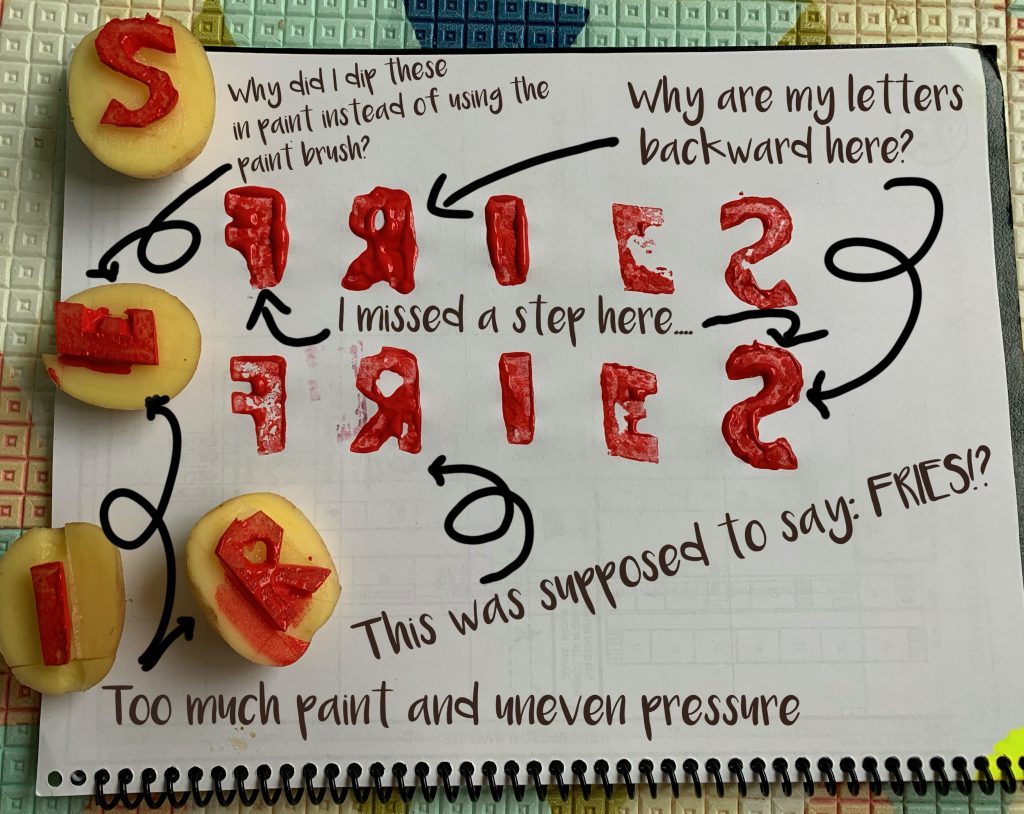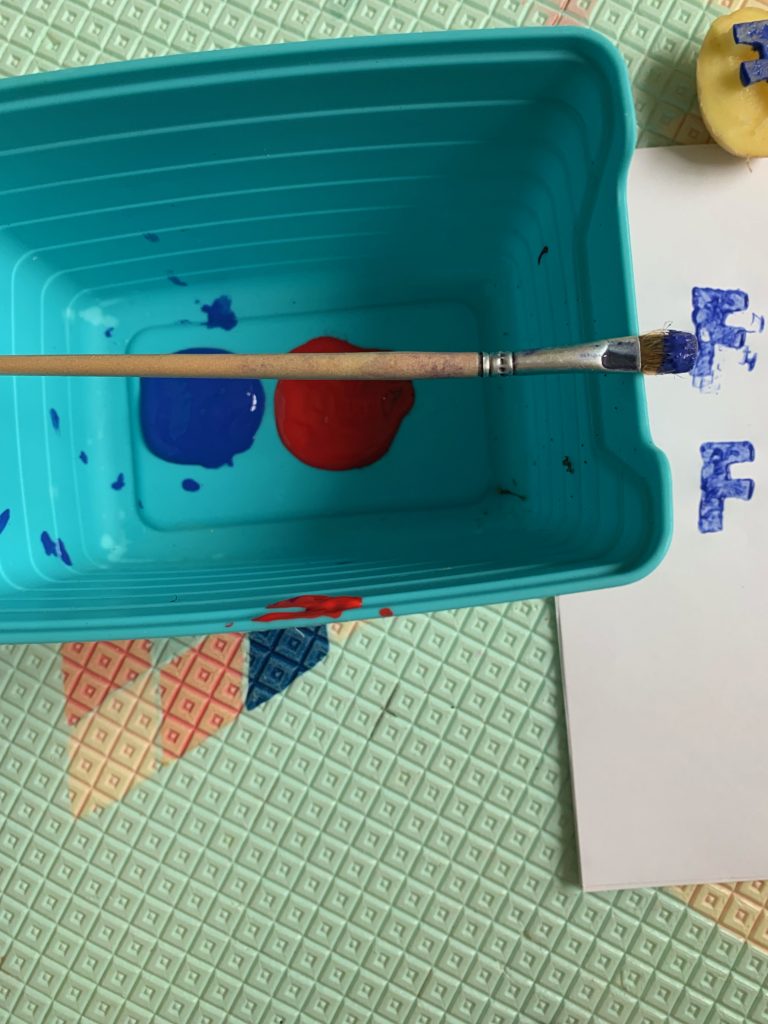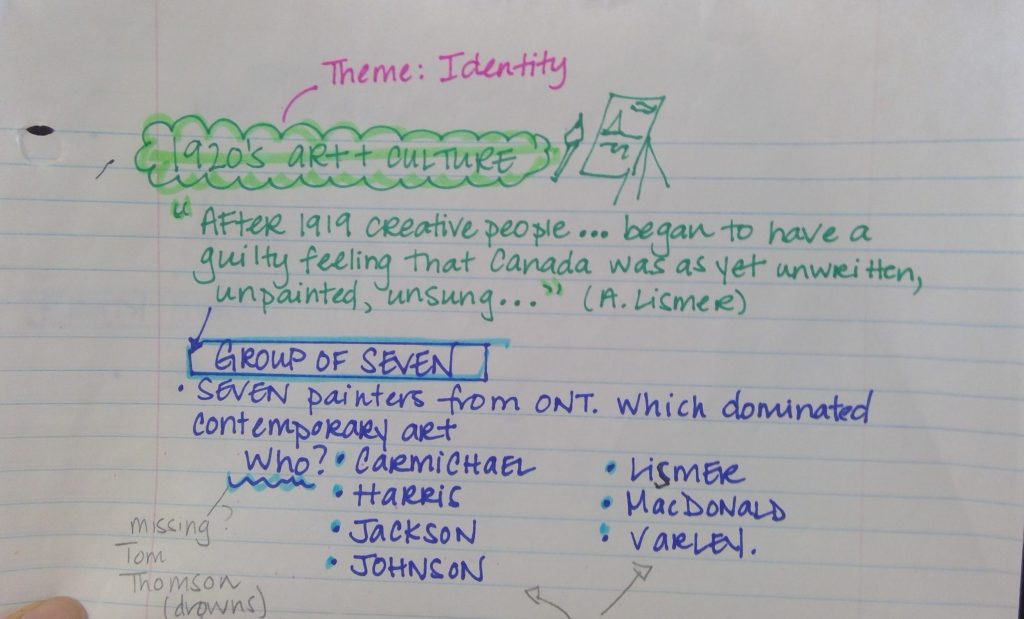Here is my potato printing journey.
I figured since I was going to make FRIES after this project, I thought the word choice was fitting!
ROund #1 – Things did not go as planned…

Round #2 – Execution is much better..

Initial Reflection
I thought this was going to be simple – cut potatoes, use paint, stamp. I was clearly manipulated by the super cute YouTube video. Carving letters into a semi-damp potato is no easy task. Despite drying the cut side repeatedly, the marker smudged many times and I found it difficult to follow the tracing. Also, the letter ‘S’ was the worst of the bunch. I also did not follow my tracing perfectly, therefore each letter was a bit wonky looking- definitely not like my personal penmanship. After grappling with the knife and cut potatoes– I was ready to stamp. I took it upon myself to pour red paint into a bucket and began dunking the cut letters into the colour red. First letter: F. Yes, F — for fail. The letter came out backward. I tried flipping it around, looking at it desperately, but alas, I forgot letters are not mirrored in stamps! Looking at my word, I knew I had to redo 4/5 letters (thankfully “I” is replicated no matter which way you cut it). I still decided to stamp out my word, dunking and stamping. I soon realized I needed two hands to get a decent looking letter and that I needed to go easy on the paint. I knew at the end of the first round, I had to head back to the potato cutting board.
the cut letters into the colour red. First letter: F. Yes, F — for fail. The letter came out backward. I tried flipping it around, looking at it desperately, but alas, I forgot letters are not mirrored in stamps! Looking at my word, I knew I had to redo 4/5 letters (thankfully “I” is replicated no matter which way you cut it). I still decided to stamp out my word, dunking and stamping. I soon realized I needed two hands to get a decent looking letter and that I needed to go easy on the paint. I knew at the end of the first round, I had to head back to the potato cutting board.

Using the other side of my previously cut potatoes, I set out to trace out the letters: “FRES” in a mirrored fashion (which was difficult and I kept double-checking I was doing it correctly). Once I had my fresh stamps, I squeezed some blue paint into the pot and grabbed my 3-year-old’s beat up paint brush. This time I was set to do this right. I meticulously painted each letter blue, careful enough not to overdue the paint to paper ratio. I used two hands to press into the paper (I also added a piece of cardboard underneath paper for stability). Alas, I printed FRIES, not like twins, more like sisters. I can say I preferred the aesthetics of my first print the best.
Pulling it together – time, mechanization of writing, and oral history
This entire process took about 40 minutes, much longer than I thought it would take to cut potatoes (we are a potato eating family).
The mechanics of writing have always been alluring to me; I would spend countless house retaking notes through school spending a meticulous amount of energy perfecting my penmanship to my personal preference. I think I did this because i felt liek a part of me was reflected in the text. Below is a photo of some class notes I shared with my students using my Surface camera. Notice that I use capital letters in the middle of my sentences and lowercase letters to begin sentences. I also tend to use different colours for topics and themes. I also add symbols and images, (poorly drawn) to try and help the more visual learners in the class. Now, some students LOVE my handwritten notes while others find them SO CONFUSING.
 I think this photo highlights the preferences and complexities of the mechanization of writing.
I think this photo highlights the preferences and complexities of the mechanization of writing.
The two-part podcast this week, “From the Vault: Invention of the Book” the tyrant comment returns, but this time Lamb & McCormick (2021) defend that that written text, or the codex, “has removed the whims of the tyrant” [9:52]. While I see their justification: written text can be referenced and people can be held accountable with a piece of actual semi-objective text. I, do, however believe that Indigenous peoples, especially Elders are in many ways like a codex. Albeit, ‘people’ are not written memories, these stories and teachings have been handed down to and for specific peoples across generations. Elders are the references, they are the stable and permanent history. Of course memories change and the book might not (usually they do — through editions and updates), but the book is not as autonomous as we think. Haas comments on this last week, that the effects of text “may be varied, elaborate, complicated, and far from immediate. (Haas, p.18, 2013). Essentially, text is subjective, which is shown through my own example. In fact, oral storytelling is much like the codex, and is not impartial. Similar to how a scribe would have the authority to alter text when making copies, the same theory applies here. So why does the codex somehow become superior and “endure over oral history” [6:34] when it’s actual not fixed. Like Boroditsky’s (2011) article from the week before, language allows “a way of perceiving, categorizing and making meaning in the world, an invaluable guidebook developed and honed by our ancestors”. She is exactly right, language – that of oral storytelling is a guidebook.
The most illuminating point made through the podcast (which I totally enjoyed,) came at the end of the final episode. Lamb & McCormick (2021) comment on the physicality of text, be it through scroll, or codex may be shaping our minds. Basically, how the text appears, our preferences of flipping, etc. may in fact impart our thinking. Now this makes it even more clear that the text is not autonomous, and speaks to certain minds.
I have included an interactive map which outlines which Indigenous languages are spoken in BC and what percent of the population is speaking the language. I understand why there is such a push to revitalize language, be it through technology or not, as the language is the codex, it is the story.
References
Boroditsky, L. (2011). How language shapes thought. Scientific American, 304(2), 62-65.
CBC News. (2021, April 20). Traditional Anishinaabe songs & stories just a click away thanks to new website. Retrieved from https://www.cbc.ca/news/canada/thunder-bay/first-nations-elders-website-1.5993540
Haas, C. (2013). “The Technology Question.” In Writing technology: Studies on the materiality of literacy. Routledge. (pp. 3-23).
Lamb, R. & McCormick, J. (Hosts) (2021, May 7). “From the Vault: Invention of the Book Part 1 and 2”.[Audio podcast episode]. In Stuff to Blow Your Mind. iHeartRadio. https://tinyurl.com/v2yz5



